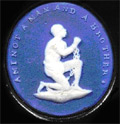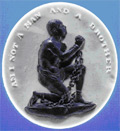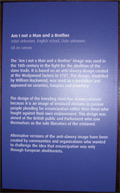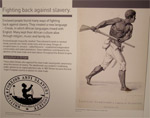Topic two: The image of the supplicant slave: advert or advocate?
The image of the supplicant slave is central in the public perception of slavery and abolition in Britain. It has endured as a symbol since its conception by Josiah Wedgwood and members of the Clapham Sect. It features today in museums and publications as the Abolition Act of 1807 is commemorated. This prevalence and almost dominance in the commemorative scheme is largely unquestioned. Can this image, which often takes pride of place in books and exhibitions, be so easily displayed? Tackling these issues necessitates an examination of the history of the image, the message that it carries and the story that it tells.
'Am I not a man and a brother?'

Wedgwood supplicant slave
Photo: Helen Weinstein
Josiah Wedgwood's image of an enslaved African, kneeling, manacled hands outstretched, with the title 'Am I not a man and a brother', is viewed as the symbol of the struggle for abolition and eventual emancipation. It is an almost inevitable inclusion in any discussion of the work of the abolitionists, Clarkson, Wilberforce, Buxton and Equiano. As Britain commemorates the 1807 Abolition Act the image was once again at the forefront, reproduced in newspapers, television programmes, books and museum displays. It appears as singularly capable of communicating the cause and ideals which the abolitionists strove to convince first the British people and then the British parliament of in the late eighteenth and early nineteenth centuries. The image was reproduced on a variety of items throughout this period and was also utilised in the struggle for the ending of the slave trade in America. Indeed, a later version of the image depicting a similarly entreating, though female African slave, was used to aid the cause of American abolitionists by linking the growing movement for womens' rights with the ending of enslavement.
Is it all that it appears to be?
It is still viewed today as a powerful emotive piece which communicates the ethics, morality and the humanitarian mission of the abolition movement. It is considered to be an effective means of imparting upon its audience that a shared basis of humanity is in existence. The legacy of the image is however questionable, recently some have argued that the image is highly derogative to the enslaved peoples of Africa. To depict the enslaved African as begging for their freedom, pleading for the kindness and generosity of others so that they might be set free from bondage, is considered at best to be unhelpful and at worst continuing the very prejudice and discrimination which enslavement installed. The image presents one view of the enslaved; that of the humble, grateful, respectful African who suffered passively until their cause was taken up by a right-minded minority in Britain. It is an image which does not depict the resistance and revolutions instigated by enslaved peoples. Neither does it depict the physical brutality and mental anguish that enslavement created. The use of this image must therefore be derived from an informed consideration of what its inclusion in a museum or publication is supposed to achieve, the way in which the image already forms a part of one particular narrative concerning enslavement and most significantly what is expressed through this image.
Charity, morality, identity and social standing

An information board from the Wisbech and Fenland Museum
Photo: Helen Weinstein
Courtesy: Wisbech and Fenland Museum
Larger image (45KB)
We are today confronted constantly with disturbing images from around the world of wars, political violence, famines and natural disasters. These images are such a regular feature in newspapers and television broadcasts that it might be thought that the public might grow accustomed to them. Occasionally however these images are also used to spearhead charitable organisations' drives to encourage public donations to a cause. These images are used to provoke, to force a perhaps desensitised public into shock, to recognise that at this moment other people are suffering. It is in this context that many view the image of the supplicant slave. Recent books examining the history of the abolition movement have focused on this capacity. Reddie (2007: 179) refers to the image as the 'pièce de résistance' of the campaign. Hochschild (2005: 128) described it as a 'forerunner of the political lapel buttons we use today.' Such comparisons are not entirely helpful in this circumstance, as the image communicated meaning in a very different manner.

Wedgwood supplicant slave
Photo: Helen Weinstein
Designed by members of the Clapham Sect in 1787, the image was conceived with the certainly paternalistic and perhaps superior opinions of many of the group. It was deemed appropriate for the committee's religious values that enslaved peoples were to be freed but it was as a deferential, grateful figure that this freedom was to be bestowed upon. The image embodied the ideals of the abolitionists, morality, virtue, truth; it did not embody the enslaved, of torture, oppression and resistance. In Britain, largely unaware of the brutal plantation system, the plight of the enslaved individual was sold to the public through this image, quite literally in-fact, as the figure was reproduced upon a variety of items of jewellery and pottery. This consumption is significant for understanding the image, as in the eighteenth century, the nascent age of consumerism, to possess the fashionable marked the individual as part of society, as possessing its social mores and ethics (Brewer and Porter 1993: 6). Those who wore the medallions, cufflinks or broaches, and ate off or displayed the plates, were therefore not expressing solidarity with those who were enslaved; they were expressing support and association with the largesse of the abolitionists (Oldfield 1995: 155).
The legacy of this kindness
It is in this guise that the image has been inherited through succeeding generations in Britain. It serves as a reminder of the kindness and charity of British campaigners and of the compassion of Britain as a nation itself. It forms the central part of the 'traditional narrative of abolition', as defined by Oldfield (2006), as the triumph of white abolitionists. The image has contributed to the popular memory of the work of abolitionists in Britain, a memory which concentrates on those who fought in Britain for the ending of the trade (Wallace 2006). The image therefore forms an advert for the abolitionists not an advocate of the African. Its continued use relies on the popular memory of abolition and emancipation, of the good work, moral fibre and courage of the abolitionists. The image therefore ensures that its audience does not bear witness to the experiences of the enslaved but to the work of those who campaigned for an ending of the Atlantic slave trade. As a symbol, though the body of the enslaved is depicted, the actual corporeal experience of the enslaved is absent; the pain and horror of enslavement is not evidenced by the image. The body of the enslaved becomes in this way a symbol of abolitionism not of the enslaved themselves. As such the image is a vehicle for the 'traditional narrative', ingrained in one particular mode of thinking. It forms a surface by which an audience can look upon the body of the enslaved yet forget the enslaved. Its inclusion within museum displays and its continued appearance within media reports of the 1807 commemorations is testament to the image's lasting effect on its audience. It is not an item which can be fitted into displays and alternative narratives without consideration of the association it brings with it. It is a piece which engenders a specific way of remembering and a particular mode of seeing the past (Berger 1972: 23).
Recontextualised

Information board from the Wilberforce House Museum
Photo: Helen Weinstein
Courtesy: Wilberforce House Museum, Hull.
Larger image (76KB)
Recently, a number of museums have responded to these issues by including within displays of the image of the supplicant slave alternative perspectives on the message it conveys. This has usually taken the form of provisos which attempt to explain how Wedgwood's image was intended for the British public and Parliament. These efforts therefore can only ever remedy the issues regarding the meaning of the image in the past rather than the present. A criticism of the image for its contemporary audience should be incorporated into its usage to aid exhibitions and public means of remembrance. One method of achieving this would be to contrast the image with others that depict the enslaved. The image, if placed alongside drawings, paintings and photographs of the bodies of the enslaved which portray rebellions, resistance, torture and mutilation, is forced to be integrated into an alternative context.

Information board from the British Empire and Commonwealth Museum
Photo: Laurajane Smith
Courtesy: British Empire and Commonwealth Museum, Bristol
Larger image (45KB)
The power the image has of seemingly representing the body of the enslaved but at the same time obscuring it becomes observable in this manner. Placed alongside the image of Toussaint l'Ouverture for example, or the above example of Leonard Parkinson, the supplicant slave image can be reduced and rethought. The image, rather than being viewed by itself, is witnessed as one part of the history of enslavement: the primacy accorded to Wedgwood's image is by this means negated. The narrative communicated by the image of the supplicant slave is powerful and dominating. It is a means by which individuals can remember the morality of the abolitionists rather than the actions of the slave traders, a means by which individuals can recall how the abolitionists assisted an oppressed and grateful population, rather than the rebellions which ensured that enslavement was impossible. A variety of authors have commented upon the way enslaved Africans have been depicted in artistic representations (Dabydeen 1987; Wood 2000). The way in which the body of the enslaved has been made to stand for the morality of the abolitionists is an aspect which is as yet unexamined. This is a significant area of consideration however as a repositioning of this image is essential in the memory of the European slave trade.
Debate
Amongst other questions this article raises it might be worth considering the following discussion points.
- Should the image of the supplicant slave have a prominent place in the commemorative scheme of the 1807 Abolition Act?
- Can this image be used in a manner which promotes the enslaved rather than the morality of the abolitionists?
- What can or should be done to the image to ameliorate its dominance?
The problems raised here are pertinent for all involved in the commemoration of the 1807 Act; museum practitioners, local communities, academics and the museum visitor. In effect, this debate strikes at the very core of the act of commemoration itself, as it focuses on how and what we remember about the past. In responding to these questions we need to consider practical as well as theoretical alternatives. This article, it is hoped, will stir discussion and question a hitherto predominantly unquestioned part of the heritage of 1807: this in an invitation to debate about how the past is presented.
Respond to this article email: arch-1807@york.ac.uk
Bibliography
- Berger, J. (1972) Ways of Seeing. London. Penguin/BBC Books.
- Brewer, J. and Porter, R. (1993) Introduction. In J. Brewer and R. Porter (eds.) Consumption and the World of Goods. London, New York. Routledge. pp. 1-15.
- Dabydeen, D. (1987) Hogarth's Blacks: Images of Blacks in eighteenth-century English art. Manchester. Manchester University Press.
- Hochschild, A. (2005) Breaking the Chains: The British struggle to abolish slavery. London. Pan.
- Oldfield, J.R. (1995) Popular Politics and British Anti-Slavery: The mobilisation of public opinion against the slave trade 1787-1807. Manchester. Manchester University Press.
- Oldfield, J.R. (2006) Chords of Freedom: Commemoration, ritual and transatlantic slavery. Manchester. Manchester University Press.
- Reddie, R. (2007) Abolition! The struggle to abolish slavery in the British colonies. Oxford. Lion Hudson.
- Wallace, E.K. (2006) The British Slave Trade and Public Memory. New York. Columbia.
- Wood, M. (2000) Blind Memory: visual representations of slavery in England and America 1780-1865. Manchester. Manchester University Press.
